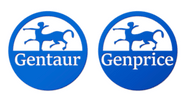Description
APOBEC3A Antibody | 14-400 | Gentaur UK, US & Europe Distribution
Host: Rabbit
Reactivity: Human
Homology: N/A
Immunogen: Recombinant fusion protein containing a sequence corresponding to amino acids 1-199 of human APOBEC3A (NP_663745.1) .
Research Area: Cancer, Cell Cycle, Signal Transduction
Tested Application: WB
Application: WB: 1:200 - 1:500
Specificiy: N/A
Positive Control 1: HT-29
Positive Control 2: N/A
Positive Control 3: N/A
Positive Control 4: N/A
Positive Control 5: N/A
Positive Control 6: N/A
Molecular Weight: Observed: 26kDa
Validation: N/A
Isoform: N/A
Purification: Affinity purification
Clonality: Polyclonal
Clone: N/A
Isotype: IgG
Conjugate: Unconjugated
Physical State: Liquid
Buffer: PBS with 0.02% sodium azide, 50% glycerol, pH7.3.
Concentration: N/A
Storage Condition: Store at -20˚C. Avoid freeze / thaw cycles.
Alternate Name: APOBEC3A, apolipoprotein B mRNA editing enzyme, catalytic polypeptide-like 3A, ARP3, PHRBN, bK150C2.1, phorbolin 1, A3A
User Note: Optimal dilutions for each application to be determined by the researcher.
BACKGROUND: This gene is a member of the cytidine deaminase gene family. It is one of seven related genes or pseudogenes found in a cluster, thought to result from gene duplication, on chromosome 22. Members of the cluster encode proteins that are structurally and functionally related to the C to U RNA-editing cytidine deaminase APOBEC1. The protein encoded by this gene lacks the zinc binding activity of other family members. The protein plays a role in immunity, by restricting transmission of foreign DNA such as viruses. One mechanism of foreign DNA restriction is deamination of foreign double-stranded DNA cytidines to uridines, which leads to DNA degradation. However, other mechanisms are also thought to be involved, as anti-viral effect is not dependent on deaminase activity. Two transcript variants encoding different isoforms have been found for this gene.






